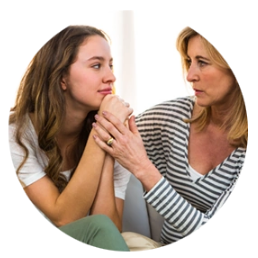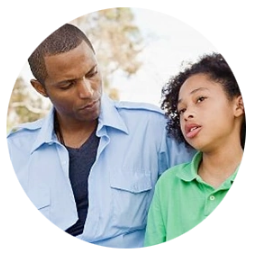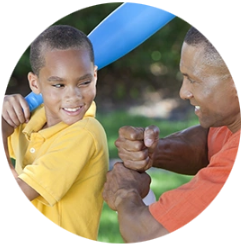At what age should you talk to your child about sexual abuse? It’s best to start talking as early as possible, using age-appropriate conversations. Here are the basics for parents and caretakers.
It’s helpful to learn the facts about healthy sexual development as well as child sexual abuse. First be sure you are comfortable talking about the topic. If you are comfortable using the words, your child will feel that and know that they can talk to you. A conversation like this doesn’t need to be a big “talk,” but can be something you address gradually. If you are relaxed and easy to talk to, you can be an approachable adult who your child can ask questions or voice any concerns.
FOR MORE INFORMATION, VISIT THESE RESOURCES
- Overview statistics on child sexual abuse from the National Center for Victims of Crime
- Basic facts about child sexual abuse and what you can do from Darkness to Light
- Tip sheets on how to talk to children from Stop It Now!
- Resources and materials from national organizations compiled by the National Sexual Violence Resource Center
- Overview of sexual abuse and tips to prevent it from the American Academy of Pediatrics
- Parent Toolkit on child abuse, including sexual, physical and emotional abuse, from the U.S. Center for SafeSport
It’s also helpful to know the typical behaviors for each stage of a child’s development. Know what the normal stages of development are for preschool, elementary, middle school children and young teens. Learn the signs of sexual abuse. It will be easier to identify normal behaviors and behaviors that might be of concern. Don’t wait until it is too late to learn the signs of sexual abuse.
FOR MORE INFORMATION, VISIT THESE RESOURCES
- An overview of healthy childhood sexual development from the National Sexual Violence Resource Center (PDF)
- Summary of sexual behaviors in children from the American Academy of Pediatrics
- Sexual development and behavior in children from the National Child Traumatic Stress Network and the National Center on the Sexual Behavior of Youth
- Information on Growth and Development for Parents from Advocates for Youth
Conversations with your child or teen should be open, casual and ongoing. As your child’s understanding of the world grows, conversations can also grow.
HOW TO TALK TO YOUR CHILD
Discussions about sexuality and sexual abuse can start long before a child reaches puberty. The sooner a parent initiates conversations about healthy sexual development, how the body changes and sexual abuse, the better. Here some tips on starting the conversation.
- Names for body parts: Properly naming and talking openly about body parts helps children gain respect for their bodies and the bodies of others. These conversations help children to not be ashamed or embarrassed by their bodies and prevent secrecy and silence. Teaching children names of body parts also gives them language to ask questions or talk to you about any worries and concerns.
- Model healthy boundaries: Teaching your child that it’s OK to say “no” to being touched and to respect when someone tells them “no” lets them set and respect healthy boundaries. If it’s helpful, talk with other adults about boundaries and ask them to respect if a child says “no” to a hug or other physical affection. This sends a consistent message about respecting each other’s boundaries. And be sure to respect a child’s boundaries in play and in affection.
- Be sure talks are ongoing: There’s no need to put everything into one big “talk” about sex. Talking openly about developing bodies, boundaries and sexuality can be part of ongoing everyday conversations.
- Be involved in your child’s life: Being engaged in your child’s activities, asking about what she or he is doing, getting to know parents of your child’s friends and knowing the other adults your child might talk to helps you stay connected and involved.
- Talk about media and technology: As technology use increases, it’s an ever-growing part of children and teens’ lives. Asking questions about technology you don’t understand, talking about what your child is doing and supervising access — especially during the younger years — will help you monitor what your child sees and hears. Like teaching children to cross the street, it takes time to teach them how to be online safely.
FOR MORE INFORMATION, VISIT THESE RESOURCES
- Tip sheet for talking to children and teens from Stop It Now!
- Guide to talking with your children about sexual abuse from the Committee for Children
- A guide for parents with tips on talking to your children from the Enough Abuse Campaign
- Resources for families and communities from the National Center for Missing & Exploited Children
- KidSmartz resources for parents of children K–5, including parent tips and activities, from National Center for Missing & Exploited Children
HOW TO TALK TO YOUR TEEN
As a child becomes a teenager, conversations about preventing sexual abuse can become more complicated. Teenagers will begin to look for relationships outside the family for friends, security and advice. They also may be confused or embarrassed about their own developing sexuality, which makes talking to parents or guardians more difficult. As teens go through these stages of exploration, they are also more at risk, so answering questions and being approachable is one way to help keep teens safe.
- Be realistic and educate yourself: When teens seek information about sex, their “friend” sources may not be reliable. Parents can try talking with their teens, and letting them know they are available. If a teen is resistant to talking, parents can ask if there is someone else they would feel comfortable with and/or find books or videos with age-appropriate information.
- Don’t put off conversations: Parents can find small ways to let their teens know they’re available to talk. Even if the teen does not want to talk, you are letting them know you are approachable.
- Explain consent: It’s important for teens to know they have the right to give or refuse consent, regardless of their relationship status. They can say “no” at any time. And it’s just as important that they respect the rights of others to say “yes,” or “no.” Read more about the legal role of consent (and search state-specific definitions of consent).
FOR MORE INFORMATION, VISIT THESE RESOURCES
- NetSmartz resources an online safety education program providing age-appropriate activities to help children be safer online, from National Center for Missing & Exploited Children
- Tip sheet for talking to children and teens from Stop It Now!
- An overview of adolescent sexual development from the National Sexual Violence Resource Center
- An overview of consent for teens at Love is Respect from the National Domestic Violence Helpline
FAMILY SAFETY PLANNING
One way to protect your children is to create a family safety plan. A safety plan gets everyone in the family on the same page and lets you begin important conversations about boundaries, healthy interactions and how to talk about changing expectations as children grow older. Here are some ideas to get started:
- Educate everyone in the family: Make sure every adult knows about healthy sexual development in children and the warning signs of child sexual abuse. Teach children proper names for body parts so they are aware of their own bodies.
- Start talking: Talk with your children and teens and let them know you are open to questions. If you have used the words out loud, then they will be more comfortable coming to you with concerns.
- Set clear family boundaries: Set clear family guidelines for personal privacy, respect, safety, healthy communications and behavior. Talk about them and model respect for these guidelines. Equally important are conversations about what to do when someone ignores or violates a guideline within or outside of the family. As a child grows older, boundaries and guidelines may need to change.
- Get safe adults involved: Identify people outside the family you can talk to if there’s a concern. Be sure no one in your family is isolated. However, if even if a close friend or relative seems too friendly or overly interested, ask more questions. They may not be safe to trust with your child.
- Know your local resources: Learn about the agencies in your area and how to contact them. Consider making a list of resources for everyone to have.
FOR MORE INFORMATION, VISIT THESE RESOURCES
- Tip sheet on how to create a family safety plan from Stop It Now!
- Comprehensive toolkit about child sexual abuse for parents from the National Child Traumatic Stress Network (PDF)
- Children’s advocacy center locations from the National Children’s Alliance
- Contact information for rape crisis centers and state and territory coalitions from the National Sexual Violence Resource Center
SAFETY IN THE COMMUNITY
Organizations working with children and teens focus on creating safe environments for them to grow, explore, learn and have fun. Part of their commitment is to ensure children and teens are safe while participating in organization-sponsored activities.
- Check out the organizations your child attends: To prevent the risk of child sexual abuse, organizations create policies and organizational cultures where child sexual abuse is discussed, addressed and prevented. Each organization will be different (e.g., summer camp, religious organization or after-school program) because of the organization’s mission, the age of the children or teens they serve and the activities they offer.
- Promote safe policies: If you are a part of an organization working with children or teens, you can help promote new policies that support children and keep them safer. The Centers for Disease Control and Prevention established six components of effective child sexual abuse prevention:
- Screening and selecting employees and volunteers
- Guidelines on interactions between individuals
- Monitoring behavior
- Ensuring safe environments
- Responding to inappropriate behavior, breaches in policy and allegations and suspicions of child sexual abuse
- Training about child sexual abuse prevention
- Encourage organizations to collaborate: Organizations can also work together to create communities that are safer for all children and families.
FOR MORE INFORMATION, VISIT THESE RESOURCES
- Free resources to prevent sexual abuse in youth-serving organizations from GateKeepers for Kids
- Free training and educational resources for athletes participating in sports and their parents from the U.S. Center for SafeSport
- Safe to Compete resources for parents of youth athletes and for youth sports organizations, from National Center for Missing & Exploited Children
- Prevention strategies and tip sheets for youth-serving organizations from Stop It Now!
- Community-based prevention plan training by the National Criminal Justice Training Center
SAFETY IN SCHOOLS
Safety at school is important. Whether at the K-12 or college level, schools offer a unique opportunity to address sexual abuse, sexual assault and sexual misconduct for students in their care — both in preventing and responding to sexual assault and misconduct.
- Know your state laws: For schools working with children and teens, adults are mandated to report any suspicion of sexual abuse against a child in their care to law enforcement or child protective services. Each state has different laws on mandatory reporting of sexual abuse against children; contact information for child protective services is available at ChildWelfare.org.
- Be aware of federal protections: Federal laws protect students from sexual abuse, sexual assault and sexual misconduct, helping to provide for safe, supportive learning environments.
- Title IX prohibits sex-based discrimination in all education programs or activities that receive federal financial assistance, including situations of sexual assault and misconduct. It applies to public and private schools, kindergarten through postsecondary. The Title IX coordinator for a district or school can provide additional information about a school’s grievance procedures.
- The Clery Act requires colleges and universities to prepare an annual security report with campus crime statistics, and to advise the campus community where they can find information about registered sex offenders. Many colleges and universities have developed protocols and memorandums of understanding with the local police to coordinate community responses to any student who reports sexual assault.
- Know the school’s policies: In addition to the criminal justice system addressing sexual assault, schools also have processes to ensure student safety. Schools may classify sexual misconduct as policy violations, often more broadly defined than criminal offenses, which could result in suspension or expulsion. The school administration can provide additional interim measures such as changing a residence on campus, issuing no contact orders on campus, adjusting class schedules, restricting access to certain campus events, etc.
- Talk about prevention: Prevention is key to school safety. Colleges are required under the Clery Act to provide bystander intervention programs and other prevention strategies. Many K-12 schools offer school-based prevention programs in collaboration with local and national prevention organizations, local rape crisis centers, state and territory coalitions and child advocacy centers. These programs and initiatives are focused on efforts to prevent child sexual abuse and sexual assault of adults before anyone is harmed. Find out if your school or campus is implementing effective prevention programs through the resources below.
FOR MORE INFORMATION, VISIT THESE RESOURCES
- Mandatory child abuse & neglect reporting laws on the Child Welfare Information Gateway
- Overview of effective child sexual abuse prevention programs from the National Sexual Violence Resource Center (PDF)
- Analysis of school-based child sexual abuse prevention programs from the National Institute of Justice
- Training guide for administrators on adult sexual misconduct by the U.S. Department of Education (PDF)
- Tips for new college students from RAINN
- Support resources, educational tools and organizing information for college students from It’s On Us.
RESOURCES FOR K-12 ADMINISTRATORS AND EDUCATORS
- Safe Place to Learn resource package from the National Center on Safe Supportive Learning Environments
- Guide to responding to child sexual abuse allegations against educators by the National Child Traumatic Stress Network (PDF)
RESOURCES FOR POSTSECONDARY EDUCATION ADMINISTRATORS AND EDUCATORS
- Information on protecting students from sexual assault from the Office of Violence Against Women
- Center for Changing Our Campus Culture, a federal resource clearinghouse
- Campus safety and security data analysis tool from the U.S. Department of Education








